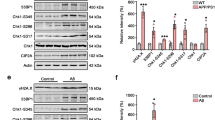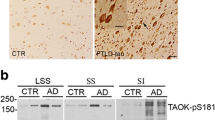Abstract
Neurofibrillary tangles are one of the pathologic hallmarks of Alzheimer’s disease (AD). They are composed of paired helical filaments (PHF) containing hyperphosphorylated forms of tau. Hyperphosphorylation of certain tau sites favors its dissociation from the microtubules (MT), interfering with axonal transport and compromising the function and viability of neurons. Reappearance of cell cycle proteins have been reported in neurons exhibiting tau aggregation, suggesting that an aberrant cell cycle occurs before neurons die. Cell cycle suppression in neurons is crucial to survival, thus prevention of progression through the cell cycle may offer a therapeutic approach. Using a neuroblastoma cell line overexpressing 3-repeat (3R) tau, we investigated the effects of cell cycle inhibitors on tau phosphorylation. G2/M phase inhibitors did not alter phosphorylation of tau at Ser-202 and Ser-396/404 at the lower doses, but did at higher doses. Ser-202 and Ser-396/404 are phosphorylation sites of early and late neurofibrillary tangles, respectively, in AD. Cisplatin, a G1 phase inhibitor, did not phosphorylate tau. Cyclophosphamide and phosphoramide mustard, DNA cross-linking agents, decreased tau phosphorylation at Ser-396/404 site, but increased phosphorylation at Ser-202. These studies demonstrate that the G2/M blockers have a dose-dependent effect on tau phosphorylation. This seems to be a consequence of both the disruption of MT-organization and MT-dynamics when doses are higher, but only a disruption of MT-dynamics with lower doses. These results are also in agreement with the lack of phosphorylation seen for cisplatin, another inhibitor that produces disruption of the MT-dynamics.





Similar content being viewed by others
References
Amato, S. F., Swart, J. M., Berg, M., Wanebo, H. J., Mehta, S. R., & Chiles, T. C. (1998). Transient stimulation of the c-Jun-NH2-terminal kinase/activator protein 1 pathway and inhibition of extracellular signal-regulated kinase are early effects in paclitaxel-mediated apoptosis in human B lymphoblasts. Cancer Research, 58(2), 241–247.
Andorfer, C., Acker, C. M., Kress, Y., Hof, P. R., Duff, K., & Davies, P. (2005). Cell-cycle reentry and cell death in transgenic mice expressing nonmutant human tau isoforms. Journal of Neuroscience, 25(22), 5446–5454.
Becvarova, P., Skorpikova, J., Janisch, R., & Novy, J. (2006). A Vinca alkaloid effect on microtubules of Hela cells. Scripta Medica (BRNO), 79(1), 19–34.
Bhalla, K. N. (2003). Microtubule-targeted anticancer agents and apoptosis. Oncogene, 22(56), 9075–9086.
Bharadwaj, R., & Yu, H. (2004). The spindle checkpoint, aneuploidy, and cancer. Oncogene, 23(11), 2016–2027.
Billingsley, M. L., & Kincaid, R. L. (1997). Regulated phosphorylation and dephosphorylation of tau protein: effects on microtubule interaction, intracellular trafficking and neurodegeneration. Biochemical Journal, 323(Pt 3), 577–591.
Blagosklonny, M. V., & Fojo, T. (1999). Molecular effects of paclitaxel: myths and reality (a critical review). International Journal of Cancer, 83(2), 151–156.
Blagosklonny, M. V., Giannakakou, P., el-Deiry, W. S., et al. (1997). Raf-1/bcl-2 phosphorylation: a step from microtubule damage to cell death. Cancer Research, 57(1), 130–135.
Boekelheide, K., Arcila, M. E., & Eveleth, J. (1992). Cis-diamminedichloroplatinum (II) (cisplatin) alters microtubule assembly dynamics. Toxicology & Applied Pharmacology, 116(1), 146–151.
Burke, W. J., Raghu, G., & Strong, R. (1994). Taxol protects against calcium-mediated death of differentiated rat pheochromocytoma cells. Life Sciences, 55(16), 313–319.
Busciglio, J., Lorenzo, A., Yeh, J., & Yankner, B. A. (1995). Beta-amyloid fibrils induce tau phosphorylation and loss of microtubule binding. Neuron, 14(4), 879–888.
Cleveland, D. W., Mao, Y., & Sullivan, K. F. (2003). Centromeres and kinetochores: from epigenetics to mitotic checkpoint signaling. Cell, 112(4), 407–421.
Colvin, O. M. (1999). An overview of cyclophosphamide development and clinical applications. Current Pharmaceutical Design, 5(8), 555–560.
Eisenhauer, E. A., & Vermorken, J. B. (1998). The taxoids. Comparative clinical pharmacology and therapeutic potential. Drugs, 55(1), 5–30.
Furukawa, K., & Mattson, M. P. (1995). Taxol stabilizes [Ca2+]i and protects hippocampal neurons against excitotoxicity. Brain Research, 689(1), 141–146.
Furukawa, K., Wang, Y., Yao, P. J., et al. (2003). Alteration in calcium channel properties is responsible for the neurotoxic action of a familial frontotemporal dementia tau mutation. Journal of Neurochemistry, 87(2), 427–436.
Gorbsky, G. J. (2001). The mitotic spindle checkpoint. Current Biology, 11(24), R1001–R1004.
Ishihara, T., Hong, M., Zhang, B., et al. (1999). Age-dependent emergence and progression of a tauopathy in transgenic mice overexpressing the shortest human tau isoform. Neuron, 24(3), 751–762.
Ishihara, T., Zhang, B., Higuchi, M., Yoshiyama, Y., Trojanowski, J. Q., & Lee, V. M. (2001). Age-dependent induction of congophilic neurofibrillary tau inclusions in tau transgenic mice. American Journal of Pathology, 158(2), 555–562.
Jordan, M. A. (2002). Mechanism of action of antitumor drugs that interact with microtubules and tubulin. Current Medicinal Chemistry Anti-Cancer Agents, 2(1), 1–17.
Jordan, M. A., Toso, R. J., Thrower, D., & Wilson, L. (1993). Mechanism of mitotic block and inhibition of cell proliferation by taxol at low concentrations. Proceedings of the National Academy of Sciences of the United States of America, 90(20), 9552–9556.
Jordan, M. A., & Wilson, L. (1998). Microtubules and actin filaments: dynamic targets for cancer chemotherapy. Current Opinion in Cell Biology, 10(1), 123–130.
Jordan, M. A., & Wilson, L. (2004). Microtubules as a target for anticancer drugs. Nature Reviews Cancer, 4(4), 253–265.
Kinoshita, K., Habermann, B., & Hyman, A. A. (2002). XMAP215: a key component of the dynamic microtubule cytoskeleton. Trends in Cell Biology, 12(6), 267–273.
Li, G., Faibushevich, A., Turunen, B. J., et al. (2003). Stabilization of the cyclin-dependent kinase 5 activator, p35, by paclitaxel decreases beta-amyloid toxicity in cortical neurons. Journal of Neurochemistry, 84(2), 347–362.
Liu, F., Li, B., Tung, E. J., Grundke-Iqbal, I., Iqbal, K., & Gong, C. X. (2007). Site-specific effects of tau phosphorylation on its microtubule assembly activity and self-aggregation. European Journal of Neuroscience, 26(12), 3429–3436.
Ludeman, S. M. (1999). The chemistry of the metabolites of cyclophosphamide. Current Pharmaceutical Design, 5(8), 627–643.
Michaelis, M. L., Ansar, S., Chen, Y., et al. (2005). {beta}-Amyloid-induced neurodegeneration and protection by structurally diverse microtubule-stabilizing agents. Journal of Pharmacology and Experimental Therapeutics, 312(2), 659–668.
Mollinedo, F., & Gajate, C. (2003). Microtubules, microtubule-interfering agents and apoptosis. Apoptosis, 8(5), 413–450.
Sponne, I., Fifre, A., Drouet, B., et al. (2003). Apoptotic neuronal cell death induced by the non-fibrillar amyloid-beta peptide proceeds through an early reactive oxygen species-dependent cytoskeleton perturbation. Journal of Biological Chemistry, 278(5), 3437–3445.
Trushina, E., Heldebrant, M. P., Perez-Terzic, C. M., et al. (2003). Microtubule destabilization and nuclear entry are sequential steps leading to toxicity in Huntington’s disease. Proceedings of the National Academy of Sciences of the United States of America, 100(21), 12171–12176.
Tulub, A. A., & Stefanov, V. E. (2001). Cisplatin stops tubulin assembly into microtubules. A new insight into the mechanism of antitumor activity of platinum complexes. International Journal of Biological Macromolecules, 28(3), 191–198.
Wang, T. H., Wang, H. S., Ichijo, H., et al. (1998). Microtubule-interfering agents activate c-Jun N-terminal kinase/stress-activated protein kinase through both Ras and apoptosis signal-regulating kinase pathways. Journal of Biological Chemistry, 273(9), 4928–4936.
Weaver, B. A., & Cleveland, D. W. (2005). Decoding the links between mitosis, cancer, and chemotherapy: the mitotic checkpoint, adaptation, and cell death. Cancer Cell, 8(1), 7–12.
Zhang, B., Maiti, A., Shively, S., et al. (2005). Microtubule-binding drugs offset tau sequestration by stabilizing microtubules and reversing fast axonal transport deficits in a tauopathy model. Proceedings of the National Academy of Sciences of the United States of America, 102(1), 227–231.
Acknowledgments
Phosphoramide mustard was a gift from the Drug Synthesis and Chemistry Branch, Division of Cancer Treatment, National Cancer Institute.
Author information
Authors and Affiliations
Corresponding author
Rights and permissions
About this article
Cite this article
Conejero-Goldberg, C., Townsend, K. & Davies, P. Effects of Cell Cycle Inhibitors on Tau Phosphorylation in N2aTau3R Cells. J Mol Neurosci 35, 143–150 (2008). https://doi.org/10.1007/s12031-008-9044-z
Received:
Revised:
Accepted:
Published:
Issue Date:
DOI: https://doi.org/10.1007/s12031-008-9044-z




